No matter what industry a company operates in, or its size, a company’s intellectual property is often more valuable than its physical assets. While factories and inventory can be rebuilt after a loss, losing control of intellectual property can be ruinous for companies. After reading this chapter, you should be able to apply intellectual property concepts to answer the following questions:
The Apple iPhone 4 is the latest model of Apple’s do-it-all cell phone. Since its introduction in 2007, the iPhone has redefined the “smart phone” segment of the wireless phone industry and left its competitors scrambling to catch up. Its sleek lines, gorgeous full-color display, built-in GPS navigation and camera, visual voice mail, and Web surfing capability (either over Wi-Fi or 3G phone networks) made it an instant hit, with thousands of consumers lining up for hours to have their chance to buy one. Its revolutionary business model, where thousands of software programmers could write small programs called “apps” and sell them on the App Store through Apple’s iTunes software, created a win-win-win business model for everyone who touched the iPhone. For software programmers, it was a win because small, untested, and first-time programmers could “strike it rich” by selling thousands of their apps directly to consumers without having to find a software publisher first. For Apple, it was a win because thousands of talented programmers, not on Apple’s payroll, were developing content for their product and enhancing its appeal. Apple also wins because it collects a percentage fee from every app sold on its iTunes store. And finally, consumers win because they have access to all sorts of creative programs to help them do more on their iPhones than simply make a phone call. The business has been a tremendous success for both Apple and AT&T, the exclusive service provider of iPhones in the United States.
There are quite a few companies in the industry that aren’t doing as well, from Nokia to Motorola to Sony Ericsson. If they wanted to see how Apple makes the iPhone, all they’d have to do is buy one and then take it apart to see its components (a process known as reverse engineeringThe process of tearing down a finished good to its components to figure out how it was designed or manufactured.). Or they could look at the reverse engineering conducted by iSuppli, an independent market intelligence firm.
You can see how iSuppli broke down the components in an iPhone 4 by reading this press release:
iSuppli found out that the bill of material (BOM)A list of components constituting an assembled good., or the breakdown of each component Apple purchased to assemble into an iPhone, is roughly $187.51. The most expensive components are a $27 16GB flash memory module from Samsung, a $28.50 display module that includes the iPhone’s glossy 3.5-inch screen, and a $10 touch screen assembly that includes the touch-sensitive glass on top of the screen.
Apple makes a lot of money selling iPhones. Although the $199 retail price of the 16GB iPhone 4 suggests that Apple makes only about $12 profit per phone, in reality the “cost” of the iPhone is much higher than $199, since each phone is sold with a two-year contract with AT&T service. Industry analysts estimate that AT&T pays Apple approximately $300 for each iPhone sold with an AT&T plan, in return for Apple agreeing not sell the iPhone through any other phone network.M. G. Siegler, “AT&T iPhone Deal Extended to 2010. Did Apple Mortgage Its Future for a Subsidy?” Social Beat, August 1, 2008, http://digital.venturebeat.com/2008/08/01/att-iphone-deal-extended-to-2010-did-apple-mortgage-its-future-for-a-subsidy (accessed September 27, 2010). The result for Apple is staggering profitability, with a $1.21 billion profit reported in the first three months of 2009, much of which driven by iPhone sales.Jim Dalrymple, “Strong iPhone and iPod Sales Drive Apple Profits to $1.21 Billion,” Macworld, April 22, 2009, http://www.macworld.com/article/140162/2009/04/appleearnings.html (accessed September 27, 2010). This chart (Figure 9.1 "Estimated Revenues of the Top Cell Phone Manufacturers") shows, to scale, how outsized Apple’s profits are compared to those of the rest of the industry. Apple’s profit margin, at an estimated 40 percent, is nearly double that of its nearest competitor, Research in Motion, maker of the BlackBerry.“A Visualized Look at the Estimated Revenues of the Top Cell Phone Manufacturers,” iSmashPhone, August 11, 2009, http://www.ismashphone.com/2009/08/a-visualized-look-at-the-estimated-revenues-of-the-top-cell-phone-manufacturers.html (accessed September 27, 2010).
Figure 9.1 Estimated Revenues of the Top Cell Phone Manufacturers
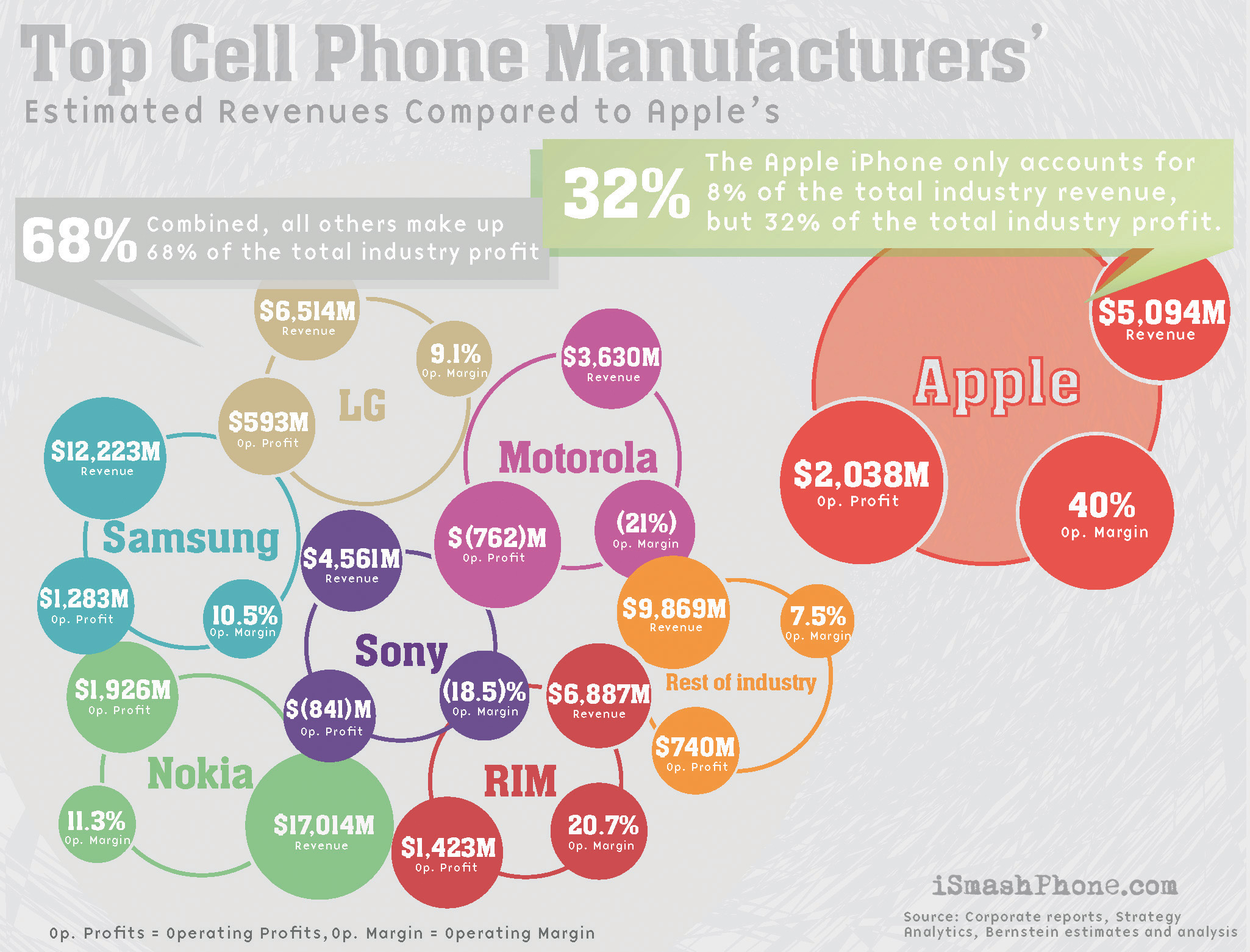
Source: Courtesy of iSmashPhone, http://www.ismashphone.com/2009/08/a-visualized-look-at-the-estimated-revenues-of-the-top-cell-phone-manufacturers.html.
If you were a competitor in the cell phone industry, you’d be sorely tempted to try to duplicate Apple’s success. After all, if it only costs $187.51 to make an iPhone, and you could sell it for a $320 profit, why not just make something that looks a lot like an iPhone? Behold the Air Phone No. 4 (Figure 9.2 "Air Phone 4"). Released in 2010, the Air Phone is made by a little-known Chinese manufacturer and looks virtually identical to the iPhone 4. It lacks many of the features of the iPhone 4 and does not run on the iPhone’s software platform, but at approximately $150 in online stores, it is proving to be a popular alternative to the iPhone.
Figure 9.2 Air Phone 4
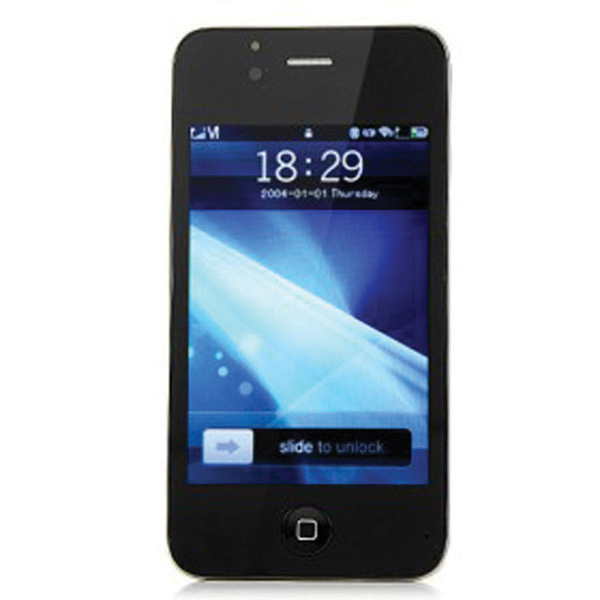
The reason that companies like Motorola and Nokia don’t simply use the bill of material generated by iSuppli to make their own iPhones, of course, is that it’s illegal. The BOM only lists the component costs to Apple; it does not capture the amount of money Apple spent in developing the product through the R&D process. The years of software and hardware development that Apple undertook to create the iPhone involve labor, just as building a skyscraper involves labor. In Apple’s case, the product of its labor is not a skyscraper or other tangible property—it is intangible property known broadly as intellectual propertyIntangible property, the product of human ingenuity, protected by law. Also known as IP., or IP. The law protects Apple’s IP just as it protects tangible things from being stolen, so any attempt by a competitor to make an iPhone clone would fail even if the technical ability to do so exists. To be legally sold in the United States, the Air Phone must be different enough from the iPhone that it doesn’t actually infringeTo step on, or violate, someone else’s property rights., or step on, any of Apple’s intellectual property rights in the iPhone.
In this chapter, we’ll discuss how the law protects IP. We’ll begin by examining how IP has been a part of the country’s foundation from its very beginning. We’ll then discuss the four major types of IP protected by the law: patents, trade secrets, trademarks, and copyright. By the end of this chapter, you’ll understand the value that IP plays in a modern economy, the challenges that companies face in doing business in countries that don’t value IP, and the devastating impact that IP infringement (including the downloading of music and movies by college students) has on copyright content holders. You’ll also be able to distinguish among the various types of IP protection and how they are similar to, and differ from, each other.
Companies (such as Apple) invest tremendous resources in developing exciting and innovative new products and services. Reverse engineering means that it would be easy for competitors to quickly figure out how these new products are manufactured, and then copy them. Intellectual property law prevents this from happening and in doing so provides incentive for individuals and companies to create and innovate.
Anyone alive when the U.S. Constitution was adopted would be surprised at the size and scope of the U.S. federal government today. What would not surprise them, however, is the existence of the U.S. Patent and Trademark Office (USPTO)United States Patent and Trademark Office. This federal agency approves patent applications and officially grants trademark status to qualified marks, but only a court can finally determine the validity of a patent or trademark application., since the establishment of a system to protect patents is one of those few congressional powers enumerated in Article I, Section 8 of the Constitution. That clause, known as the Copyright ClauseThe clause within Article I, Section 8 of the U.S. Constitution that authorizes Congress to pass laws protecting intellectual property., says that Congress may “promote the Progress of Science and useful Arts, by securing for limited Times to Authors and Inventors the exclusive Right to their respective Writings and Discoveries.” Keep the key words of this clause in mind, as we’ll come back to them later: “promote progress,” “limited times,” and “exclusive.”
The USPTO Web site is a treasure trove of information as it includes a searchable database for trademarks and patents. See if you can search these databases for well-known trademarks or patents.
Although the Constitution addresses only copyrights and patents, modern intellectual property (IP) law also includes trademarks (probably left out of the Constitution because of the relative unimportance of corporations and branding at the time) and trade secrets (a relatively new form of IP protection). Unlike other controversial portions of the Constitution, such as state rights and the role of the judiciary, the value of laws that protected authors and inventors was well accepted in 1787, when inventions of new machines were shaping up to be part of the fabric of the new country. Indeed, the attendees at the Constitutional Convention took a break from their work to watch the first steamship in the Delaware River. One of the first patents granted was to Abraham Lincoln, who drew on his experience as a young man making his way from Indiana to New Orleans along the Ohio and Mississippi rivers on a flatboat to devise a system to lift and drop boats over shallow water without dropping off their cargo. A scale model of his invention is on display at the Smithsonian (Figure 9.3 "President Lincoln’s Patent"). Lincoln, who many historians described as mechanically inclined and fascinated by engineering, felt that the patent system added “fuel of interest to the fire of genius.”
Figure 9.3 President Lincoln’s Patent
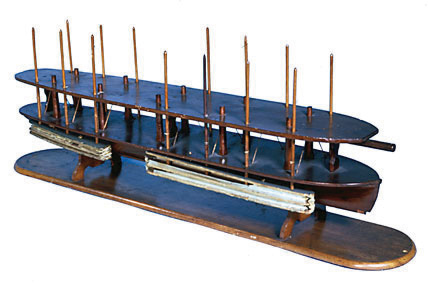
Source: Photo courtesy of the Smithsonian National Museum of American History, http://americanhistory.si.edu/collections/object.cfm?key=35&objkey=19.
Essentially, the Copyright Clause permits (even commands) the federal government to protect certain products of the mind, just as much as it protects personal land or money. If someone trespasses on your property, you can call the police and have them removed or you can sue them in court for damages. In either case, the full force and power of government is involved. The same thing can be said about IP. On the other hand, you know from your economics classes that, in general, our capitalist economy frowns on monopolies. We believe that monopolies are immune from competitive pressures and can therefore charge exorbitant prices without any regard to the quality of their product. Efficiency suffers when monopolies are allowed to exist, and ultimately the consumer loses in choice and price. If you think about it, though, the Copyright Clause essentially allows the government to create a special kind of monopoly around IP. Take, for example, a pharmaceutical company that invents a certain kind of drug and applies for a patent on that drug. If the government grants the patent, then the company can charge as much as it wants (some drugs can cost tens of thousands of dollars per year for consumers) without any regard for competitors, since competitors are shut out of that drug market by virtue of the patent. If any competitor dares to copy the drug to compete against the inventing company, the full force and weight of the government will be brought down on the competitor. Violations of patent law carry extremely stiff penalties.
How can we say that monopolies are bad, and yet grant Constitutional protection to monopolies on IP? The answer lies in the genius of the Copyright Clause itself. As in all monopolies, there are two sides: the producer and the consumer. The producer always wants the monopoly to last as long as possible, while the consumer wants the monopoly to end as quickly as possible. The Copyright Clause strikes a compromise between the producer and the consumer in two ways.
First, the Clause states that Congress can grant the monopoly only to “promote the progress of Science and Useful Arts.” In other words, the monopoly exists for a specific purpose. Note that “making Beyoncé rich” or “allowing Pfizer to make billions of dollars” is not the purpose. Rather, the purpose is progress. Granting monopolies can encourage progress by providing a financial incentive to producers. Singers, songwriters, inventors, drug companies, manufacturers—they all invent and innovate in the hope of making money. If they knew that the law wouldn’t protect what they came up with, they’d either not invent at all or they’d simply do it for themselves and their families, without sharing the fruits of their labor with the rest of society.
Second, the clause states whatever monopoly Congress grants has to be for a “limited time.” In other words, at some point the monopoly will end. When the monopoly ends, science is once again progressed because then society can freely copy and improve upon the producer’s products. Society benefits greatly from the expiration of these IP monopolies. Important drugs such as aspirin and penicillin, for example, can now be purchased for pennies and are accessible to the entire human population. Grand literary works, such as Shakespeare’s Hamlet or Beethoven’s Fifth Symphony, can be performed and enjoyed by anyone at any time without seeking permission or paying any fees or royalties. These inventions and works are in the public domainAny intellectual property not protected by law and freely available for any member of the public to use., to be enjoyed by all of us.
The Copyright Clause does not state how long the monopoly can last; it leaves that task to Congress. Congress must make the decision based on what’s best to promote progress. Remember, though, that producers want monopolies to last as long as possible. For example, consider how long copyrights last. Since 1976 copyrights have lasted for fifty years after the death of the author. After that, copyrighted works fall into the public domain (such as works by Shakespeare or Beethoven). In 1998, however, Congress began considering adding an extra twenty years to that term, for a total of seventy years after the author’s death. In the early part of the twentieth century, the United States experienced a cultural renaissance that accompanied the Industrial Revolution. The invention of the phonograph and cameras allowed the creative genius of Walt Disney, George Gershwin, and Charlie Chaplin (to name a few) to flourish. Under the 1976 copyright law, though, some of these early works (including early versions of Winnie the Pooh) were about to fall into the public domain by 1998. The United States was also under some pressure from international trading partners to increase the copyright term.
As a result of these pressures, U.S. Representative Sonny Bono (himself a popular artist together with his former wife Cher) introduced the Copyright Term Extension Act to add twenty years to copyrights. During hearings on this bill, Congress heard testimony from Jack Valenti, then president of the Motion Picture Association of America, an industry group that represents film studios and corporations. When asked how long he thought copyrights should last, he answered “Forever minus a day.” Although Sonny Bono’s bill passed, whether or not “forever minus a day” will eventually become the law as Congress seeks to strike the right balance between protection and access and whether it satisfies the Constitution’s demand that the monopoly last for a “limited” time remain unresolved questions.
The Constitution commands Congress to provide monopoly protection for intellectual property, but only for purposes of progressing science and useful arts, and only for a limited time. Content producers will always want legal protection to last as long as possible to maximize profits, while the public good benefits when content falls into the public domain. Congress is under intense pressure to resolve this tension.
Imagine that you invented the Apple iPhone 4. If you invent a patentable item that is useful, new, and nonobvious, and if you are capable of describing it in clear and definite terms, you may wish to protect your invention by obtaining a patent. A patentA federal right granted to inventors for processes, machines, and compositions of matter. grants property rights to the inventor for a specified period of time, with a utility patentThe most common type of patent, awarded for inventions or improvements to methods, processes, machinery, and compositions of matter. and a plant patentA unique patent right granted to inventors of new forms of plants. expiring twenty years following the original patent application and a design patentA unique patent right granted to protect the look, not functionality, of an invention. expiring fourteen years afterward. A patenteeHolder of a patent. owns a patent.
However, if you invented the Apple iPhone 4 while employed to perform creative and inventive work, then any patents obtained with respect to your work would be assigned to your employer. Many inventors and designers work for employers in creative and inventive capacities. This arrangement allows innovative ideas to be adequately funded in trade for the property rights resulting from patents granted to those inventions.
Three patent types exist. Utility patents may be granted for machines, processes, articles of manufacture, compositions of matter, or for improvements to any of those items. The Apple iPhone 4 certainly is the subject of utility patents. A design patent may be granted for ornamental designs for an article of manufacture. A plant patent covers inventions or discoveries of asexually reproduced plants (e.g., plants produced through methods such as grafting).
Not all items are patentable. For instance, an idea alone (without a definite description) cannot be patented. So even if you dreamed up the idea of something that looked and functioned exactly like the Apple iPhone 4, you would not have been eligible for a patent on your idea alone. Likewise, physical phenomena, the laws of nature, abstract ideas, and artistic works cannot be patented. Note, however, that artistic works can be copyright protected. Additionally, otherwise patentable subjects that are not useful, or items that are offensive to public morality, are not patentable.
So what does it mean to have a patent? Just like real property ownership, a patent confers the right to exclude others. If you owned a parcel of real property, your ownership interest would allow you to exclude others from your land. The rule of law would protect your right to exclude against the intrusions of others, which is the very essence of ownership. Likewise, a patent confers the legal right to exclude others from making, using, or selling the patented product. This is consistent with the Copyright Clause of the U.S. Constitution, which grants inventors the “exclusive Right to their…Discoveries.” For others to legally make, use, or sell the patented product, they would have to be granted permission by the patentee. This is often accomplished through a licensing agreement, in which the patentee authorizes others to sell, make, or use the product.
For instance, some genetically modified agricultural products are the subjects of utility patents. Monsanto Company patented Genuity Bollgard II Cotton, designed to resist worm damage, which can be a devastating problem for cotton farmers. This product reduces the need for farmers to spray insecticide. Patentees, such as Monsanto Company, hold many patents on agricultural products such as cotton, soybeans, canola, and corn. In the United States these patents typically protect new plant breeds as well as parts of the plants. In contrast, some countries, such as Canada, do not permit the patenting of life forms. In countries where the patenting of whole life forms is prohibited, the patents typically protect the genetically modified parts of the life form, such as the genes and the cells, as well as the process for inserting the genes into the cells.
Do genetically modified plants meet the threshold requirements to be the subject of a patent? Remember that to be a patentable item, the invention must be useful, new, and nonobvious. Genetically modified plants are useful because they possess some particular quality for which they were designed. For example, Genuity Bollgard II Cotton resists many types of damaging worms while reducing the need for farmers to use insecticide, and so this invention can be said to be useful. Likewise, some patented genetically modified agricultural products are resistant to herbicides, such as Monsanto Company’s Roundup Ready line of agricultural products. Roundup Ready products are resistant to an herbicide known as glyphosate, which is the main active ingredient in the herbicide line marketed by the Monsanto Company under the Roundup brand. These are also useful inventions, because farmers that plant those patented herbicide-resistant products do not have to wait to plant their crops until their fields are cleared of weeds. They can plant their crops before they spray herbicides because the genetically modified crops will resist the herbicide and continue to grow. This allows the farmers to put their land to use for longer periods of time and with more confidence that they can kill weeds without damaging their crops. They can do so using inexpensive methods such as by spraying herbicides, rather than hand-weeding, which is very labor intensive.
Genetically modified plants are new and entitled to be patented when no one else has applied for a patent for that particular invention. If, for example, some other company had invented the same product that eventually became known as Genuity Bollgard II Cotton before the Monsanto Company had invented that product, then the Monsanto Company would not have been permitted to patent that product, even if it had independently invented that product with no knowledge of the other invention. In this way, we can see that patents are granted in the United States by the “first to invent” rule. Many other countries follow the “first to file” rule, which means that the first applicant to file for a patent on a particular invention is eligible for the patent, regardless of who first invented it. There are legal movements to amend the U.S. Patent Act to change from “first to invent” to “first to file,” but no amendment has yet been passed.
Genetically modified plants are nonobvious inventions if they are different from what has been used before, so that someone with ordinary skill in genetically modified plant technology would not find the new invention to be obvious. For example, if the “new” invention only changed the color of one tiny cell in the entire plant, that would probably not be a patentable invention.
You might be wondering how a patent can be granted over a living thing, like a plant. As mentioned earlier in this section, in the United States living things are patentable. Living things became the legal subjects of patents when, in 1980, the U.S. Supreme Court held that a bacterium designed by its inventor to break down crude oil components was the legitimate object of a patent.Diamond v. Chakrabarty, 447 U.S. 303 (1980). Indeed, as the Supreme Court noted in that case, congressional intent regarding the U.S. Patent Act was that “anything under the sun that is made by man” is patentable. Since then, we have seen many living organisms patented. For example, the OncoMouse was among the first patented mammals. The OncoMouse is useful in medical research for its extreme propensity to develop cancer.
The patentability of life forms is a contentious issue. While the usefulness of such inventions is proven (or else they would not be patentable inventions), ethical questions abound. For example, when considering the OncoMouse, legitimate questions include whether intentionally creating life to experience pain, sickness, and medical procedures is ethical. Moreover, many people find the idea of “creating” life in a laboratory morally repugnant, as well as owning the products of that creation. Many fear a slippery slope: Today a mouse; tomorrow, a human? Of course, humans are not patentable subjects today, but the slippery slope argument often arises in such discussions. With respect to genetically modified agricultural products, many people question the wisdom of placing control and ownership over items essential to life—like staple crop seeds—into the hands of few, especially when money must be traded for the rights to use those products. This issue is particularly complicated given the fact that genetically modified agricultural products may cross-pollinate with nongenetically modified agricultural products, resulting in progeny that contains the genes or cells that are patented. When this happens, courts routinely recognize that the patentee has the rights to those progeny by virtue of their patent ownership and that the unwitting possessor of those progeny has, in fact, committed patent infringement by being in possession of those patented products without permission.
Another controversial issue surrounds the patents granted to pharmaceutical drugs. Large drug companies rely on patent law to protect their massive investment in research and development into new drugs, the vast majority of which never make it to market. For the few drugs that eventually find government approval and commercial success, manufacturers seek to extract the highest possible price during the period of patent monopoly. For example, the introduction of antiretroviral drugs has greatly extended the lives of HIV/AIDS patients, but the drugs cost between $10,000 and $12,000 per year in the United States. In many developing countries in Asia and Africa, the drugs would make a dramatic impact on human life. Some governments have therefore declared national health emergencies, a procedure under international treaties that permits those governments to force drug companies to license the formula to generic drugmakers (this is called compulsory licensingA scheme used by countries to force pharmaceutical drug licensing in light of a medical emergency.). Cipla, a generic drug manufacturer in India, manufactures the same antiretrovirals for about $350 a year, or less than one dollar a day.
The U.S. Patent and Trademark Office (USPTO) grants property rights to patentees within the United States, its territories and possessions. Patent law is complicated, and attorneys who wish to prosecuteTo apply for, and argue on behalf of, patents before the U.S. Patent and Trademark Office (USPTO). patents (file and interact with the USPTO) must have an engineering or science background and pass a separate patent bar exam. When an application is filed, the USPTO assigns a patent examiner to decide whether the patent application should be approved. While the application is pending, the applicant is permitted to use the term “patent pendingA label claiming patent protection for an application not yet granted.” in marketing the product to warn others that a patent claim has been filed. Even after a patent has been issued by the USPTO, however, the patent is merely “presumed” to be valid. If someone challenges a patent in a lawsuit, final validity rests with the U.S. federal courts. For decades, the U.S. Supreme Court routinely ignored patent appeals, allowing lower courts to develop patent law. In recent years, under Chief Justice John Roberts, the Supreme Court has dramatically increased its acceptance of patent disputes, perhaps as a sign that the Court believes too many patents have been issued.
In the last decade there has been an over 400 percent increase in the number of patents filed, resulting in a multiyear delay in processing applications. An increase in the number of business method patentsPatents granted for a way of doing business. contributed to this dramatic increase in patent applications. A business method patent seeks to monopolize a new way of conducting a business process. Figure 9.5 "Patent Filing for One-Click Web Ordering", for example, describes a method of e-commerce by which a customer can order an item and pay for it immediately with just one click of a mouse button. This one-click patentA patent granted to Amazon.com that allows customers to use one mouse click to purchase items on the Internet. was granted to Amazon.com, much to the chagrin of other online retailers such as Barnes & Noble, who were prohibited from using a similar checkout mechanism. Amazon licensed the patent to Apple so that it could feature one-click on its Web site.
Figure 9.5 Patent Filing for One-Click Web Ordering
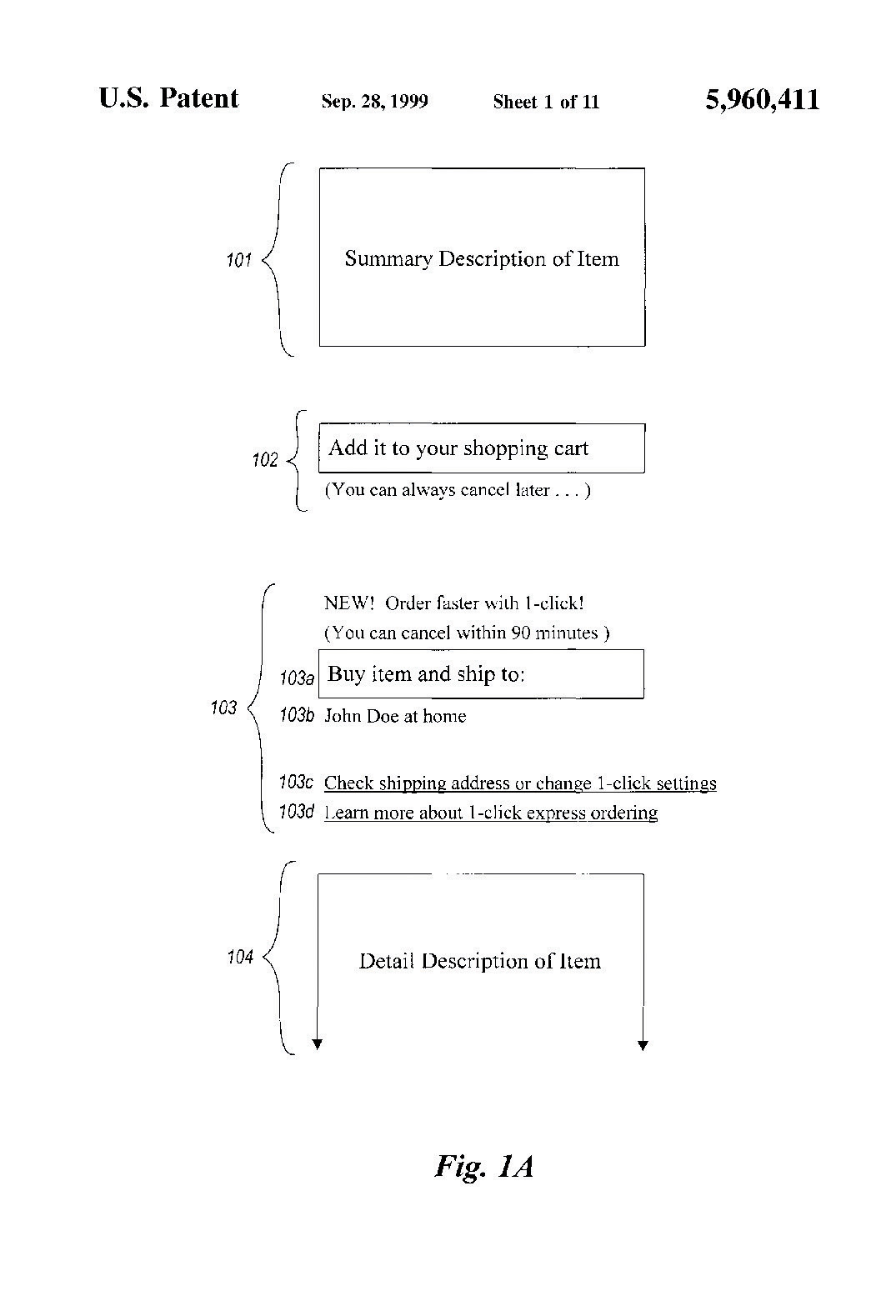
Source: Courtesy of Free Software Magazine, http://www.freesoftwaremagazine.com/files/www.freesoftwaremagazine.com/nodes/1250/1A.jpg.
Outside the United States, a patent granted by the USPTO does not protect the inventor’s interest in that property. Other steps must be taken by the inventor to protect those rights internationally. If someone possesses the patented object without permission from the patentee, then the possessor can be said to have infringed on the patent owner’s rights. Patent infringementViolation of a patent holder’s rights. is an actionable claim. A successful action may result in an injunction, treble damages, costs, and attorney’s fees. One defense to a patent infringement claim is to challenge the validity of the patent.
Nike recently sued Wal-Mart stores for selling a shoe that Nike claims infringes on its patents. The shoe sold by Wal-Mart uses technology similar to Nike’s Shox technology. Look at Nike’s complaint here:
http://online.wsj.com/public/resources/documents/nikepatentsuit.pdf
Do you think that Nike has a good claim? What should Wal-Mart’s defense be?
In recent years several companies that do nothing but sue other companies for patent infringement have emerged. These patent holding companiesA company whose sole purpose is to acquire patents and sue potential infringers. Known pejoratively as patent trolls., sometimes called patent trollsPejorative term for patent holding companies. by critics, specialize in purchasing patents from companies that are no longer interested in owning them and then finding potential infringers. One such company, NTP, sued Research in Motion (RIM), the maker of the BlackBerry device, for a key technology used to deliver the BlackBerry’s push e-mail feature. Faced with a potential shutdown of the service, RIM decided to settle the case for more than six hundred million dollars.
Imagine that you are in an antique store and find a nineteenth-century ledger book for sale, originally from the W. B. Morrison & Co. Old Corner Drug Store in Waco, Texas. Among the recipes for hair restorers and cough syrups, something in particular catches your eye—a recipe entitled D Peppers Pepsin Bitters. What if you also knew that Dr. Pepper was first created and served in that very drugstore? What if you offered to pay two hundred dollars for the old ledger book, even though if it did contain the recipe for Dr. Pepper, it would be worth far more? After all, according to the company that manufactures Dr. Pepper, only three people know the recipe to that very closely guarded trade secret. Something very similar to this happened to Bill Waters. He found the ledger book in an antique store, and he paid two hundred dollars for it. However, at the time, he did not know that the book might date back to the exact time and place from which the popular soda was created. In fact, he did not even notice the recipe until later, and it took him several more days to recognize the possibility that it might be an early version of Dr. Pepper.
Unlike patents, a trade secretAnything of value a company takes reasonable steps to protect from disclosure. can last forever. That is, it can last forever if the owner of the secret can, well, keep it a secret. If someone uses lawful means to uncover the secret, then the secret is no longer protected by the secret’s owners. Does this include reverse engineering? Yes. Reverse engineering is an absolutely legal means of discovering a trade secret. What about ferreting out secrets from an employer’s safekeeping, while employed and under a binding confidentiality agreement? No. That is an actionable claim for misappropriation, and the secret’s owners can pursue damages.
Trade secrets are unlike patents in another important way. With a patent, the inventor must specifically disclose the details of the invention when applying for a patent. This means that the inventor has not protected the secret of the invention. However, in exchange for this disclosure, a patent owner has a legal monopoly over the property for a specified period of time. So even if others discover the secret of the invention (not a difficult task since patent applications are public record), they are prohibited from making, using, or selling it without the patentee’s permission. After the patent expires, then the patentee no longer has a property right to exclude others.
So what is a trade secret? It is, in short, secret information. This information may include a process, formula, pattern, program, device, method, technique, or compilation. For many companies, lists of suppliers, costs, margins, and customers are all trade secrets. Soft drink recipes, KFC’s eleven spices, the donut mix sent to Krispy Kreme franchisees, the Big Mac’s special sauce, and even the combination of wood that is used in the burning process to make Budweiser beer are all trade secrets. Additionally, the information derives actual or potential economic value from being a secret that is not readily discoverable by others, and the information is the subject of efforts to keep it a secret. While most states have adopted the Uniform Trade Secrets Act (UTSA)A model law to protect trade secrets, adopted by over forty states., not all have, so the definition of trade secret can vary by jurisdiction. Unlike patents, trademarks, and copyrights, there is no federal law protecting trade secrets.
A claim for misappropriationAppropriating wrongly or without justification. may be brought when a trade secret has been wrongfully obtained, such as through corporate espionage or bribery. Generally, according to the UTSA, misappropriation occurs if the secret was acquired by improper means, or if the secret was disclosed or used without permission from the secret’s owner. Damages may include actual loss and unjust enrichment not captured by actual loss. Additionally, in cases of willful or malicious misappropriation, double damages may be awarded, as well as attorney’s fees.
So what if you are never lucky enough to discover a multimillion-dollar secret recipe hidden away in an antique shop? As long as the recipe is not patented, you can try to reverse engineer it. If you succeed, you can use it immediately. However, if you are working for an employer in a creative capacity, working with others to develop the secret, and if you have agreed not to use trade secrets, then the right to the trade secret will belong to your employer, at least in most jurisdictions. Ask Peter Taborsky, an undergraduate student at South Florida University in 1988. According to Taborsky, while working in the university’s chemical engineering lab, he began conducting experiments on his own. He discovered a highly effective method for treating sewage. The university demanded that he hand over his notebooks that contained the secrets of this invention. Taborsky refused and filed for a patent for his invention, which he received. However, the university pressed criminal charges for stealing trade secrets. Taborsky lost his case and found himself in a maximum-security facility working on a chain gang.
So does Bill Waters need to worry about Dr. Pepper’s owners suing him for misappropriation or pressing criminal charges for stealing trade secrets? No. He lawfully obtained the ledger book by purchasing it in the open market. Additionally, according to a company spokesman, the ingredient list under D Peppers Pepsin Bitters is most likely an old remedy for a stomachache rather than any version of the recipe for Dr. Pepper. Even if Mr. Waters had accidentally stumbled on the exact Dr. Pepper recipe, he would have a good argument that the company did not take steps to keep the secret a secret. If it had, he could argue, the company never would have allowed the recipe out of its sight.
Trade secrets last forever if the owner of the secret keeps the secret. However, if someone else discovers the secret through a lawful method, then the owner of the secret has no right to exclude others from using the secret. Unlawfully obtaining a trade secret is called misappropriation, which is an actionable claim. The Uniform Trade Secret Act has been adopted by most (but not all) states, so different jurisdictions have different rules of law concerning trade secrets.
Figure 9.7 McDonald’s, One of the Most Recognized Trademarks in the World
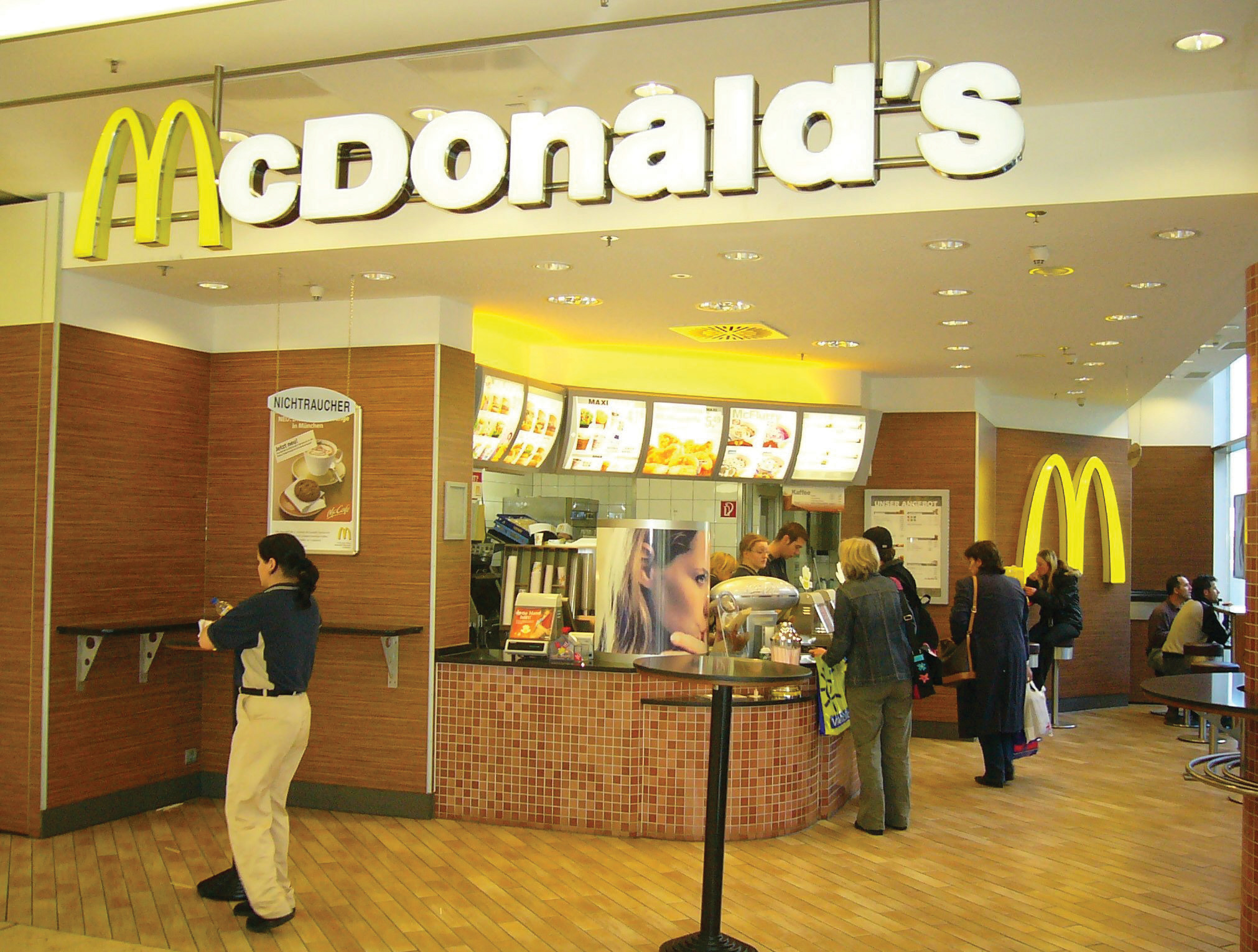
Look at Figure 9.7 "McDonald’s, One of the Most Recognized Trademarks in the World". It’s obviously a McDonald’s restaurant, but can you tell where this restaurant is? Is it in a mall or airport? Is it in Trenton, Toronto, or Tokyo (or, as it turns out, Messestadt Riem in Germany)? Without additional information, it may be impossible to tell. And yet, no matter where you are in the world, if you enter this McDonald’s restaurant, there are certain standards that you expect. You would expect to find a Big Mac on the menu, perhaps Chicken McNuggets and french fries too. You would expect those menu items to taste the same as they do in your local McDonald’s. Perhaps you’d expect a certain level of service from the employees, a certain value proposition for your money, a certain look from the uniform and fixtures, or perhaps a clean restroom. If you walked into this McDonald’s restaurant and found out that it was in fact not McDonald’s, you might be confused. The ultimate goal of trademark law is to prevent this consumer confusion. To prevent any other restaurant from using the name McDonald’s, or from using a logo that looks like a stylized “M,” McDonald’s can trademark both its name and logo (and a lot of other elements of its brand as well). In this section, we’ll examine how trademark law accomplishes this goal.
A trademarkAny logo, mark, sound, or other identifying characteristic that signifies the unique origin of particular goods or services. is any kind of name, logo, motto, device, sound, color, or look that identifies the origin of a particular good or service. Something begins to look like a trademark when a consumer identifies it with a particular origin. For example, someone buying a Diet Coke knows that he or she is getting a carbonated beverage from the Coca-Cola Company. If he or she bought a Diet Cola, on the other hand, there’s no association in the mind with any particular company, so it could be from Coca-Cola, Pepsi, or any number of other companies. The key is that consumer identification with a specific origin. If a consumer thinks of a class of goods rather than one specific origin, then it’s not a trademark. So, for example, when a consumer hears “aspirin,” he or she thinks of a class of goods with no particular origin because aspirin is not a trademark. But if a consumer hears “Bayer,” he or she thinks of a specific aspirin from a specific source, making “Bayer” a trademark.
http://www.uspto.gov/go/kids/kidsound.html
Can sounds be trademarked? Yes! Some sounds are instantly recognizable, such as AOL’s “You’ve Got Mail” and Twentieth Century Fox’s movie opening scene. Click the link to explore other trademarked sounds.
A federal law, the Lanham ActFederal law protecting trademarks., protects trademarks. Unlike copyrights and patents, trademarks can last forever and are not subject to the Constitution’s “limited time” restriction. Since the objective of trademark law is to prevent consumer confusion, the public good is best served by allowing companies to maintain their trademarks as long as consumers associate a trademark with a specific origin. The moment they no longer make that association, however, the trademark ceases to exist.
If you are considering marketing as a career, you will become intimately familiar with the concepts related to branding and the value of branding. At its core, marketing involves the science of relating to consumers, telling them an authentic story about your product and service, and satisfying their wants and needs. Having a brand is essential to carrying out this objective, and it can lead to startling profits. The Apple and iPhone brands, for example, are very strong and yield billions of dollars in profits for Apple. Luxury brands are particularly aware of this phenomenon, as often their brand alone can justify pricing far above a similar good. Gucci, such as this store in Hong Kong (Figure 9.8 "Gucci Store in Hong Kong"), trades on the value of its brand to command premium prices (and margins) in the marketplace. Brands such as Rolex, Hermes, Rolls-Royce, and Bentley have similar business models. These brands are all trademarks—indeed, all brands are either registered trademarks or are trademark-able because they share the common feature of consumer identification. Be careful, though. “Trademark” and “brand” are not interchangeable terms because not all trademarks are brands.
Figure 9.8 Gucci Store in Hong Kong
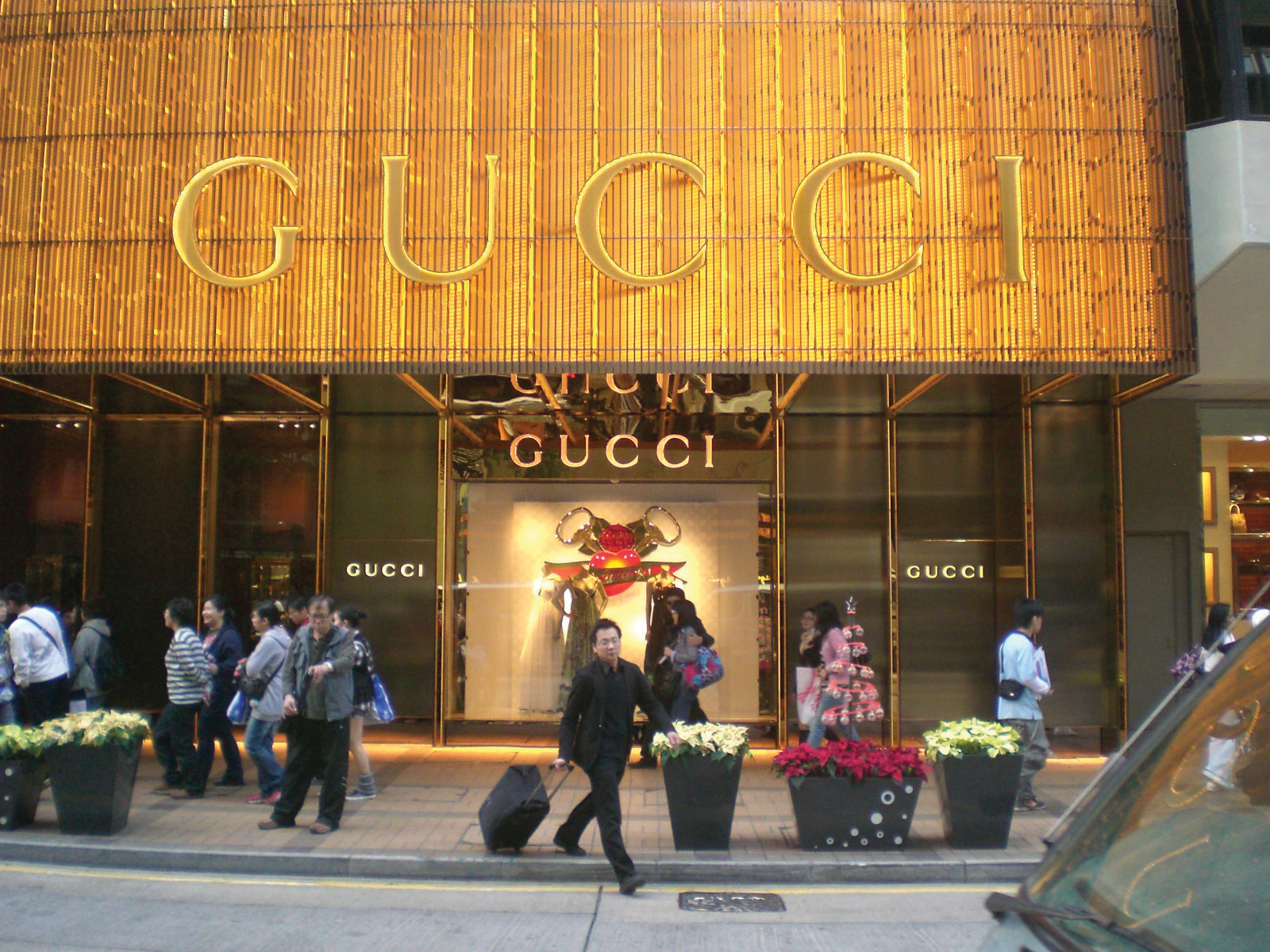
Trademark law is especially important for luxury brands such as Gucci.
Source: Photo courtesy of Maizeam, http://commons.wikimedia.org/wiki/File:HK_TST_Canton_Road_GUCCI_Shop.JPG.
So what can be a trademark? Obviously, words can be trademarked. When it comes to trademarks, distinctiveness is good. Therefore, an invented word is the best type of trademark. In 1997, for example, when Stanford grad students Larry Page and Sergey Brin were brainstorming names for their new Internet search engine, they settled on the word “Google,” a play on “googol,” which means 1 followed by 100 zeroes. They felt the name reflected their goal to organize the staggering amount of information available on the Internet. On the other hand, regular words can also become trademarks, as long as consumers identify them with a particular source. Amazon, for example, is the name of the world’s longest river, but it’s also the name of an online retailer. Since consumers now identify Amazon.com as an online retailer, the name can be trademarked. Another example is the phrase “You’re Fired” when used in a television program. The phrase was made popular by billionaire Donald Trump and has such lasting recognition now that it’s unlikely any other television show could use that phrase as a central part of its theme.
Consider what would happen if you tried to trademark your name. If your name happens to be Sam Smith, you’d probably have a pretty hard time getting a trademark for your name. If, however, you called your business Sam Smith anyway, and started growing your business so that eventually, over time, consumers began to identify “Sam Smith” as your business, then your name has acquired secondary meaning and can be trademarked. Thus, Sam Adams is a trademark for a beer, Ben & Jerry’s is a trademark for ice cream, and Ford is a trademark for a motor vehicle.
http://www.npr.org/templates/story/story.php?storyId=19227066
Can a sportscaster trademark the phrase “Are you ready to rumble”? Can Paris Hilton trademark the phrase “That’s hot”? As long as the public associates these phrases with a distinctive origin, the answer is yes. Listen to this National Public Radio broadcast for more examples.
Note that when you get a trademark, it’s typically granted for a specific category of goods. The same name can sometimes be used for multiple categories of goods. The name Delta, for example, is a trademark for both an airline and a brand of faucets. Since there is little chance that a consumer will be confused by an airline or faucet brand, trademark law allows these dual registrations. On the other hand, some brands are so strong that they would probably stop registration even for a completely different category of goods. McDonald’s is a good example of this. The McDonald’s trademark is one of the strongest in the world, meaning that it is instantly recognizable. In 1988, for example, hotel chain Quality Inns decided to launch a new line of budget motels called “McSleep.” McDonald’s sued, claiming trademark infringement. McDonald’s claimed that consumers might be confused and believe that McDonald’s owned the hotel chain. A federal judge agreed and ordered Quality Inns to change the name of the chain, which it did, to Sleep Inns.
Trademarks go beyond simply a company’s name or its logo. A color can be trademarked if it’s strong enough to create consumer identification. Pink, for example, is trademarked when used for building insulation by Owens Corning. All other insulation manufacturers must use different colors. Sounds can be trademarked too, such as MGM Studios’ “lion’s roar.” Even a certain “look” can be trademarked if a consumer identifies it with a certain origin. Thus, the distinctive colors, materials, textures, and signage of a Starbucks or T.G.I. Friday’s are considered trade dressThe distinctive and unique look, feel, or shape of a product or service that signifies unique origin. and cannot be copied. A bottle shape can be considered trade dress, too, such as the shape of a nail polish bottle (Figure 9.9 "OPI’s Nail Polish Bottle"). OPI, a nail polish manufacturer, has registered this bottle shape with the U.S. Patent and Trademark Office (USPTO) and is suing other manufacturers that use a similarly designed bottle. Interestingly, courts have been reluctant to grant certain smells trademark protection, even though it can be argued that certain fragrances such as Old Spice or CK One are distinctive. Imagine the chaos that would ensue if one company claimed trademark protection for vanilla or strawberry scents—consumers would ultimately be robbed of choice if that were to happen.
A trademark is not limited to a name or logo used to sell goods. If a company provides a service (as opposed to selling goods), it too can receive trademark protection. In this case it’s called a service markTrademark for an entity providing services, as opposed to goods.. Facebook, for example, is a service mark. A trademark can also be used to demonstrate certification meeting certain standards, such as the Good Housekeeping Seal of Approval. If you study operations management, you’ll learn about the International Organization for Standardization (ISO) and its various standards for quality management (ISO 9000) or environmental quality (ISO 14000). The Forest Stewardship Council (FSC) allows its logo to be used on paper products that come from sustainable forests, while certain foods can be labeled “Organic” or “Fair Trade” if they meet certain standards as established by governmental or nongovernmental organizations. Each of these marks is an example of a certification markA trademark representing a good or service meeting minimum standards established by owner of the certification mark.. Finally, a mark can represent membership in an organization, such as the National Football League, Girl Scouts of America, Chartered Financial Analyst, or Realtor (Figure 9.10 "“Realtor” Certification Mark"). Each of these is known as a collective markA trademark representing membership in a group as established by owner of the collective mark.. The rules that apply to trademarks apply equally to service marks, collective marks, and certification marks.
Figure 9.9 OPI’s Nail Polish Bottle
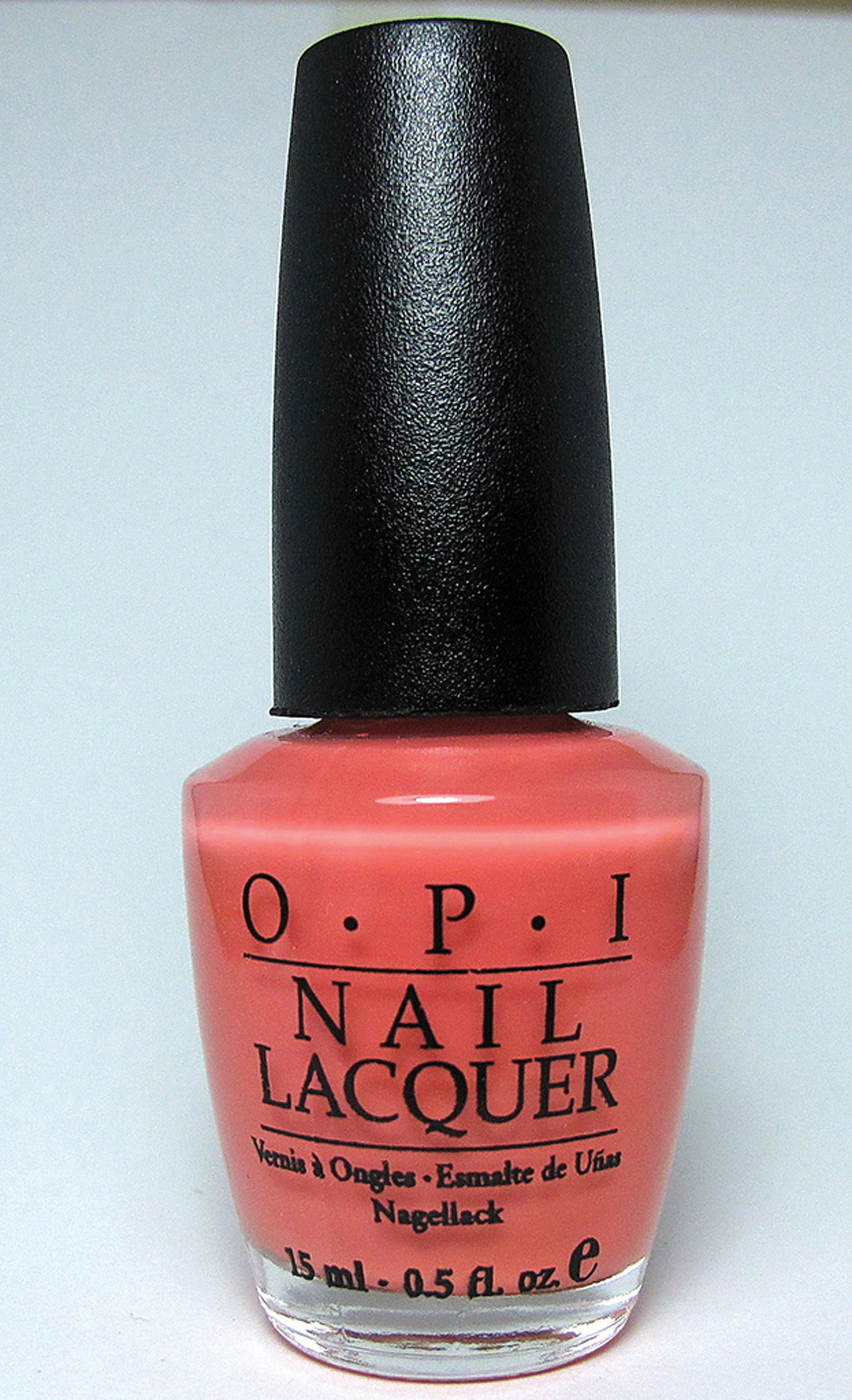
A bottle’s shape can be trademarked if it is distinctive enough.
Source: Photo courtesy Jessica Ta, http://www.flickr.com/photos/blogggles/4288368487.
If a color or sound can be trademarked, is there anything that cannot be trademarked? The Lanham Act excludes a few categories from trademark registration, mainly for public policy purposes. Obviously, trademarks will not be granted if they are similar or identical to a trademark already granted. If you’re starting a new company, it’s a good idea to make sure that not only is a domain name available for your company’s name, but that the name isn’t already trademarked by someone else. Trademarks also cannot contain the U.S. flag, any government symbol (such as the White House or Capitol buildings), or anything immoral. Trademarks cannot be merely descriptive. (Thus every restaurant is allowed to offer a “Kid’s Meal,” but only McDonald’s can offer a “Happy Meal.”)
Figure 9.10 “Realtor” Certification Mark
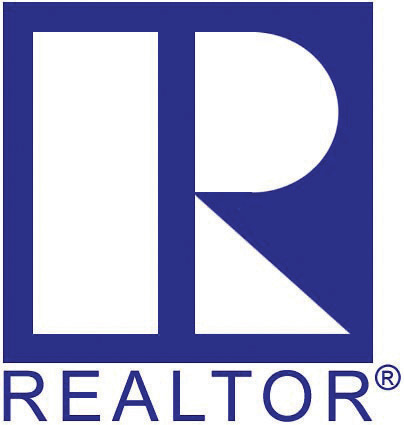
Whether or not a region can be trademarked (a geographic indicatorA system whereby names for products, especially foodstuffs, are reserved exclusively for products originating from a particular region., or GI) is the subject of some controversy, especially with our trading partners. “Maine Lobster,” “Napa Valley Wine,” or “Florida Orange Juice,” for example, may indicate to some consumers the origin of a particular lobster or bottle of wine or orange juice, and thus may be of commercial value to distinguish the product from competitors from other regions. For the time being, these foods must come from Maine, California, or Florida to avoid liability under consumer protection statutes for fraud (lying) about their origin. What happens, though, if consumers lose the association with the region? For years, sparkling wine manufacturers in Champagne, France, have fought to prevent this from happening by requiring that only sparkling wine made in the Champagne region be called “champagne.” Now, food producers (especially in the European Union) are seeking similar protection under international trademark law for Feta, Parmesan, Gorgonzola, Asiago, and hundreds of other names.
A trademark is valid as long as consumers believe that the mark is associated with a specific producer or origin. If the mark refers to a class of goods instead, then the trademark can no longer exist. This process is called genericideA former or claimed trademark indicating a general class of goods, not eligible for trademark protection.. Many words today once started as trademarks: furnace, aspirin, escalator, thermos, asphalt, zipper, softsoap, cellophane, lite beer, Q-tip, and yo-yo are all examples of trademarks that are now generic and have therefore lost legal protection. To prevent genericide from occurring, trademark owners must take active steps, often costing millions of dollars, to educate consumers on the importance of using their trademarks properly and to prosecute infringers. For example, when you hear the word “Kleenex,” do you think of a brand of tissue owned by Kimberly-Clark, or do you think of tissues generally? Does “Rollerblade” refer to a brand of in-line skates, or to all in-line skates? In Southern states, does “Coke” refer to a Coca-Cola, or to soft drinks generally? When you run a “Xerox” photocopy, is it on a Xerox photocopier or some other machine? These trademarks, all currently active and worth billions of dollars to their owners, are in danger of becoming generic in the United States. If that happens, the companies will lose control of the marks and the public (and competitors) will be free to use those words just as they use “aspirin” and “yo-yo” today. Xerox has taken many steps to educate the public about its trademark, including running print advertisements in business periodicals. In one of these ads, the text says, “When you use ‘Xerox’ the way you use ‘aspirin,’ we get a headache.”
Trademark infringement occurs when someone uses someone else’s mark, either completely or to a substantial degree, when marketing goods or services, without the permission of the mark’s owner. Obviously, making your own pair of jeans and slapping a “Levi’s” label on it, or making your own handbag and sewing a “Coach” label on it, constitutes trademark infringement. When Apple first released the iPhone, to its embarrassment it found out that “iPhone” was already a registered trademark belonging to Cisco, another company, for a phone used for placing phone calls over the Internet. To avoid trademark infringement liability, Apple had to pay Cisco an undisclosed sum to purchase the trademark. Ford found itself in a similar situation when it released a supercar called the “Ford GT.” Ford made a similar racing car in the 1960s called the “GT 40” but lost control of the trademark after production ceased. Unable to reach agreement with the current trademark owners, Ford settled for releasing the new car as simply the “GT.”
The law also permits trademark owners to sue infringers who use their marks to a substantial degree. For example, when Samsung announced its new smart phone, the Black Jack, the makers of the BlackBerry device sued for trademark infringement. When a software company released a product to eliminate unwanted e-mails called “Spam Arrest,” it was sued by Hormel, makers of Spam canned luncheon meat. When a small coffee shop in Syracuse, New York, opened as “Federal Espresso,” the shipping company FedEx filed a trademark infringement claim.
Even if a trademark owner doesn’t believe a similar use of its mark would lead to any consumer confusion, it can protect its trademark through a concept called dilutionThe use of a famous trademark in a manner intended or designed to cause tarnishment of the mark.. Such was the case when an adult novelty store in Kentucky opened as “Victor’s Secret” (the owner’s name was Victor). The trademark owners of “Victoria’s Secret” filed a dilution suit in response. Traditionally, trademarks are intended to prevent consumer confusion. Dilution permits a trademark owner to stop usage of a similar word or phrase even if consumers aren’t confused. Under dilution concepts, the trademark owner only needs to show that its mark will be diluted or tarnished in some way.
Dilution is controversial in trademark law. When Congress passed the first dilution law in 1995, the Federal Trademark Dilution Act, many felt that Congress had gone too far in protecting trademarks, to the detriment of the public and small businesses. For one thing, the Act only protected “famous” trademarks. It also failed to clearly define “dilution,” and what was required for trademark owners to win a lawsuit. Finally, when the Victor’s Secret case reached the Supreme Court,Moseley v. Secret Catalogue, 537 U.S. 418 (2003)[0].[0] the Supreme Court issued some clarification. The Court ruled that to win a dilution case, a trademark owner had to show that it had suffered actual economic damage from the dilution, not merely the “likelihood” of dilution. This is a high standard for trademark owners to meet, because it means that they (1) have to wait for the diluting mark to hit the market and be used in commerce and (2) must be able to prove that they suffered economic damage from the diluting mark. Unhappy with the Court’s decision, corporations lobbied Congress to pass the Trademark Revision Dilution Act of 2006, which overturns the Moseley case. Now, trademark owners of famous trademarks only need to show a likelihood of dilution before filing a dilution lawsuit.
Companies or persons accused of trademark infringement have several defenses to rely on. The most obvious is arguing that no infringement has occurred because the two marks are sufficiently different that consumers won’t be misled. For example, in 2002 Jeep sued General Motors for infringing on what Jeep called its trademark grill. GM’s Hummer division released the H2 that year, with a similar seven-bar grill. A district court held that there was no trademark infringement because the grills were too dissimilar to cause consumer confusion. Look at the Hummer H2 grill (Figure 9.11 "Hummer H2 Grill") and the Jeep grill (Figure 9.12 "Jeep Grill"). Do you think there is a chance of consumer confusion?
Figure 9.11 Hummer H2 Grill
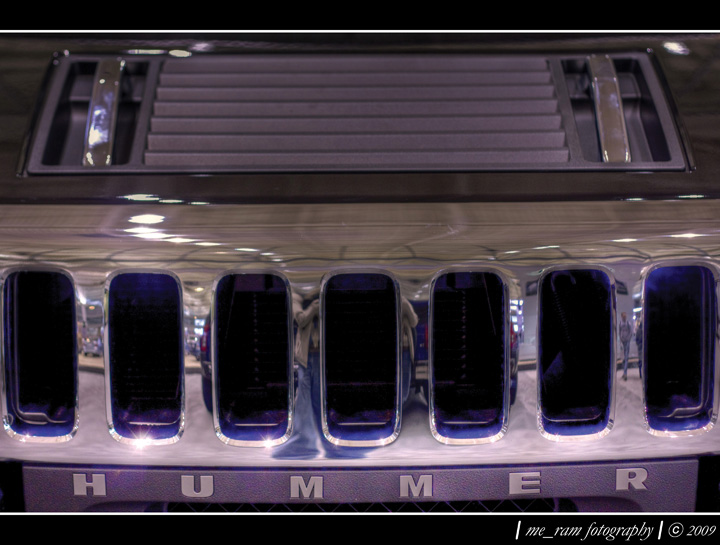
Source: Photo courtesy of Ramchandran Maharajapuram, http://www.flickr.com/photos/me_ram/3157719487.
Figure 9.12 Jeep Grill
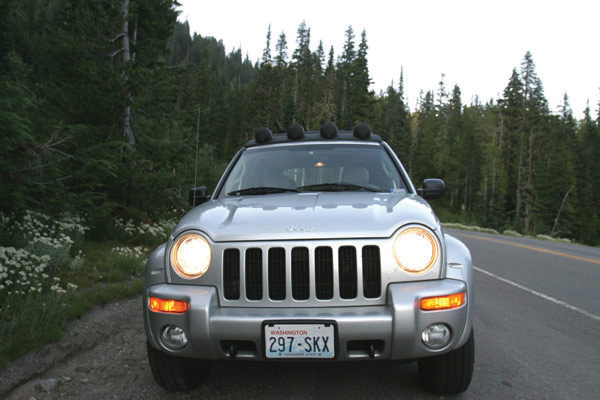
Source: Photo courtesy of 3obryans, http://www.flickr.com/photos/3obryans/1017233.
Another defense is fair useThe right of the public, under circumstances laid out in copyright and trademark law, to use protected intellectual property without permission.. The Lanham Act prohibits the use of someone else’s trademark when selling goods. It’s not uncommon to see various items such as laptop computers, telephones, soda cans, or other foods with their labels covered by stickers or blurred out on television shows and movies because of the trademark law. On the other hand, what if a company wanted to mention a competitor’s product to draw a comparison with its own product? This is called comparative advertising, and it’s considered fair use. Honda, therefore, is free to claim that its “Honda Accord is better than the Ford Taurus” in its advertising even though Ford and Taurus are both trademarks owned by Ford Motor Company.
The First Amendment also recognizes the use of parody, comedy, or satire as fair use. Comedy skits on television that make fun of, or use, company logos are an example of this fair use. Canadian nonprofit Adbusters, for example, claims to be an organization seeking to advance “a new social activist movement in the information age.” Part of its work involves making fun of corporations and consumer spending, sponsoring “Buy Nothing Day” as an antidote to the annual holiday spending season. Making fun of corporations also involves spoofing their commercial messages, as the ad in Figure 9.13 "A Parody of the Well-Known Absolut Vodka Print Ads" illustrates. Although the ad undoubtedly infringes on a trademark, it is considered fair use because of the social commentary and satire behind its message.
Figure 9.13 A Parody of the Well-Known Absolut Vodka Print Ads
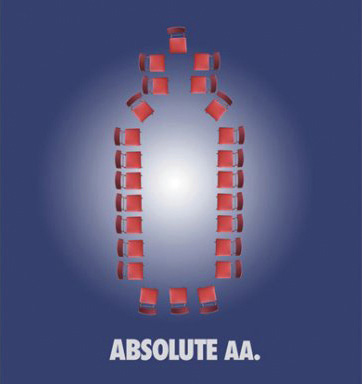
Source: Photo courtesy of Adbusters, https://www.adbusters.org/gallery/spoofads/alcohol/absolutaa.
An interesting aspect of trademark infringement arises through the use of domain names on the Internet. The practice of cybersquatting (or domain name squatting)The practice of registering Internet domain names for the sole purpose of selling the name to its rightful trademark owner. arises when a company registers a domain name containing a famous trademark in hopes of selling that trademark to its rightful owner for a large profit. The practice arose in the early days of the Internet, when domain name registration took place on a first-come, first-served basis. There is nothing wrong with registering a domain name for a generic word such as “shoes.com,” but incorporating a registered trademark into the domain name, for purposes of selling it later, is considered cybersquatting. This practice was made illegal in 1999 with the passage of the Anticybersquatting Consumer Protection ActA federal law outlawing cybersquatting.. It is only illegal, however, if the domain name is registered to make a profit through later sale. It is not illegal if someone registers the domain name in “good faith.” A good example is the domain name registered by Canadian teenager Mike Rowe in 2003. An avid computer user, he registered “mikerowesoft.com” as a domain name. Software giant Microsoft launched legal proceedings against him, claiming violation of the cybersquatting statute and trademark infringement. Rowe’s defense was that the Web site merely reflected his name and his interest in computer programming and software and was being used for that purpose. After heavy negative publicity, Rowe and Microsoft settled the case with Microsoft taking control of the domain. Another example surrounds the Nissan.com domain. Uzi Nissan, a computer storeowner, had owned the domain for years before Nissan Motors attempted to gain ownership of the domain. Since the domain was registered in good faith, no cybersquatting has occurred. The First Amendment is also a defense to cybersquatting. Web sites run by consumer activists who seek to criticize or parody companies, such as “fordreallysucks.com” or “fordlemon.com” or “peopleofwalmart.com” are not cybersquatting in spite of their use of trademarks.
Trademarks are anything that identifies the unique origin or goods or services. Trademarks are granted under federal law by the U.S Patent and Trademark Office and can last forever. When a trademark is no longer associated with a specific origin, it becomes generic and loses legal protection. Trademark owners can take legal action against infringement and dilution of their marks. Fair use of trademarks includes comparative advertising and parody. Trademark protection extends to the Internet, where mark owners can prevent bad faith domain name squatting.
The final form of intellectual property (IP) protection is copyrightThe exclusive rights of authors to their respective works, to the exclusion of others.. Like patents and trademarks, federal law protects copyright. Whereas trade secrets protect confidential company information, patents protect processes and inventions, and trademarks protect brands and identity, copyright is designed to protect creativity. It is one of the two types of IP specifically mentioned in the Copyright Clause of the U.S. Constitution. Of course, back then the only works copyrighted would have been songs, art, or works in writing. Today, copyright extends to any form of creative expression, including digital forms.
If asked to write down four numbers from one to fifty in random sequence, most of us would write four different numbers. The process of picking those numbers requires creativity, so the sequence of the four numbers you write down is copyrighted. Note that the numbers themselves aren’t copyrighted, of course. It’s just the unique sequence that you choose, the expression of your creativity, that is copyrighted. Since computer software is a compilation of binary code expressed in 1 and 0, all software is copyrighted. On the other hand, sequential page numbers or listings in a phone directory show no creativity and are therefore not copyrightable. Similarly, if a group of students were given a camera and each was asked to photograph the same subject, each student would come up with a different photograph. Each student would frame the subject differently, and that is an expression of creativity. Finally, consider the notes that you take in class for this course. A group of students could read the same textbook and listen to the same lecture, and come up with different sets of notes. Each work is unique and demonstrates creativity, so each is copyrighted.
A work must be original (not copied) and fixed in a durable medium to be copyrighted. Therefore, if you sing an original song in the shower in the morning and your roommate hears it and records it, the copyright to the song belongs to your roommate, not you. This requirement exists because it would be impossible to prove, without a durable medium, who is the original author of a work. Ideas, by themselves, cannot be copyrighted. If you had an idea for a novel about a boy wizard who goes to a boarding school with his friends and battles evil monsters while growing up, that would not be copyrighted. If you wrote a novel featuring such a story line, however, you would run the risk of violating the copyrighted Harry Potter works. A similar dispute arose in 2006 after the blockbuster success of Dan Brown’s novel, “The Da Vinci Code.” Two authors, Michael Baigent and Richard Leigh, claimed the novel infringed on their copyrighted book, “Holy Blood Holy Grail.” In their book, the authors theorized that Jesus survived his crucifixion, married Mary Magdalene, and had children. The British judge hearing the case dismissed the claims, holding that the theory was “too general or too low a level of abstraction to be capable of protection by copyright law.”Baigent v. Random House Group, http://www.scribd.com/doc/2473519/da-vinci-code-ruling-baigent-v-rhg-0406 (accessed October 2, 2010).
A copyrighted work is automatically copyrighted upon its creation. Unlike patents and trademarks, which must go through an expensive and rigorous application and approval process with the government, authors do not need to send their work to the government for approval. Although it’s a good idea to write “Copyright” or place a © symbol on the work, it’s not legally required.
Copyright protection lasts for seventy years after the death of the author. If there is more than one author, the copyright expires seventy years after the death of the last surviving author. If a company, such as a publisher, owns a copyrighted work, the copyright expires ninety-five years from the date of publication, or one hundred twenty years from the date of creation, whichever comes first. After copyright expires, the work falls into the public domain. The works of Shakespeare, Bach, and Beethoven, for example, are in the public domain. They may be freely recorded, performed, or modified without permission. If you were to record yourself reciting Shakespeare’s “To be or not to be” speech from Hamlet, however, that recording is copyrighted even though the underlying work (Hamlet) is in the public domain as a new creative expression. Classical music recordings are similarly copyrighted under the same concept.
The owner of a copyright may allow members of the public to view or use a copyrighted work, for free or for a fee. This use is contained in a copyright license, sometimes called an End User License AgreementA contract between a copyright holder and user, typically used in software licenses. (EULA) for software. A license is essentially permission from the copyright holder to violate the copyright, within the terms of the license. When you purchase a physical book or CD or DVD, for example, the copyright license allows you to view the movie, listen to the music, or read the book, in private. The license does not allow you to show the movie in class to a broad audience, or to record the music into your computer and then modify it, or to run photocopies of the book to give away or sell. These rights of reproduction, exhibition, and sale are not part of the license you received and are reserved by the copyright holder. Of course, you may purchase those rights if you wish, but they will probably cost a lot more than the price of the book or disc. Some organizations advocate the creation of a common license that authors can easily refer to if they wish to distribute their work easily. The General Public License (GPL)A widely used free software license. for software and Creative CommonsA nonprofit organization dedicated to the free distribution of creative content, and publisher of several standard copyright licenses. (CC) license for text and media are well-known examples. One right that you do have, however, in spite of any language in the license, is the right of first saleDoctrine under which the first owner of a piece of copyrighted work can do whatever he or she pleases with it, including resell the work.. Essentially this means that as the owner of the physical work, you can do with it as you please, including resell the original work.
Licenses in the digital arena can be very restrictive if you purchase digital media. Copyright holders may use schemes such as Digital Rights Management (DRM)A scheme to restrict the ability of an end user to copy or modify digital media. to limit your ownership rights in digital media. DRM limits the number of copies and devices a digital file can be transferred to, and in some cases even permits the copyright holder to delete the purchased work. Amazon.com recently deleted digital George Orwell books from owners who had purchased the works for their Kindle reading devices (Figure 9.14 "Amazon’s Kindle E-reader"), without any prior notification. This would have been impossible if the books were in a physical form. Although Amazon.com was within its rights to do so, the public outcry that followed made Amazon.com promise to not engage in such behavior again in the future.
Figure 9.14 Amazon’s Kindle E-reader
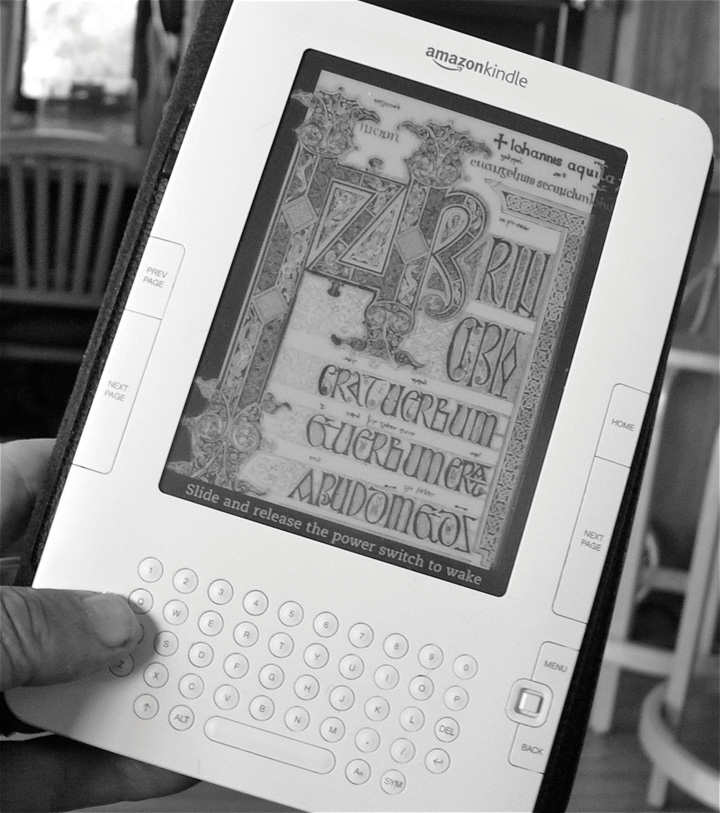
Source: Photo courtesy of Larry Page, http://www.flickr.com/photos/igboo/3879913438.
Copyright infringement occurs when someone uses a copyrighted work without permission or violates the terms of a copyright license. For example, if a classmate takes your class notes without your permission and makes photocopies of them, the classmate has infringed on your copyright. It’s also copyright infringement if you take someone else’s work and simply repackage it as your own. This happened recently to Harry Potter author J. K. Rowling. Her books created a huge fan following, and many fans gather online to discuss the Potter series. One such site is the Harry Potter Lexicon, run by Steve Vander Ark, a former school librarian. The site serves as an encyclopedia to the Harry Potter world, with reference notes on characters, places, spells, and other details. When Vander Ark announced plans to publish the contents of the Lexicon in a book format, J. K. Rowling sued, claiming copyright infringement. The judge agreed and ordered the Lexicon rewritten so that it uses less material from the copyrighted work.
Copyright infringement also occurs when you assist someone in violating a copyright, or create a device that assists in violating a copyright. Thus, Web sites such as the former Napster and Grokster, which existed solely for the purpose of facilitating illegal downloading of music, were held to be infringers even though the Web sites themselves didn’t violate any copyrights. Similarly, if you make digital media available for download for others, you are not engaged in illegal downloading but still liable for contributory copyright infringement. The recording industry, which is battling for its very survival in a new file-sharing world, pursues these cases aggressively. In June 2009, a court in Minnesota ordered Jammie Thomas to pay $80,000 per song for making twenty-four songs available for download, for a total fine of $1.92 million. In September 2009, the industry won a $675,000 verdict against a college student in Massachusetts for file sharing thirty songs. Devices that can be used for purposes other than violating copyrights (such as photocopiers, video/DVD burners, and peer-to-peer networks used for sharing research) are not considered infringing devices.
Copyright law makes a distinction between “fair” use and “infringing” use of a copyrighted work. A fair use includes copying a work for purposes of commentary, criticism, news reporting, teaching, or research. Just because a work is used in a news article or in a classroom, however, does not make its use fair. The law provides four factors that courts must consider in determining whether or not the use is fair. First, the court must consider the purpose and character of the use. Is it for educational purpose, or for making a profit? Second, the court must consider the nature of the copyrighted work. Is the work part of the “core” of the intended protection that copyright provides? Third, the court must consider the amount and substantiality of the portion used. This is an important factor—it’s one thing for your professor to copy an excerpt from a journal or book for distribution in class (probably fair) and another to copy the entire journal or book (probably infringing). Finally, the court must consider the effect of the use on the potential market for the copyrighted work. If the use is considered fair, what would it do to the market for the copyrighted work? For example, if copying an entire textbook is fair, it would probably eliminate the market for new textbooks.
In an attempt to tackle the problem of copyright infringement on the Internet, Congress passed the Digital Millennium Copyright Act (DMCA)A federal law outlawing any attempt to circumvent a copy protection device or scheme. in 1998. One portion of the law helps Internet service providers by expressly stating that those providers can’t be sued for copyright infringement if others use their networks for infringing uses. Another portion of the law helps Web sites by stating that if a Web site user uploads infringing material and the Web site complies with a copyright holder’s request to remove the material, the Web site won’t be liable for infringement. For example, if you upload a portion of a copyrighted song, movie, or television show to YouTube, you may find that YouTube has removed your clip at the request of the copyright holder. Finally, the DMCA makes it illegal to attempt to disable a copy protection device. DVD and Blu-ray Discs, for example, are copy protected to prevent them from being copied easily. Anyone who writes software (even if the software is distributed for free) that disables this copy protection device is violating the DMCA. In recent years the DMCA has been used by companies to prevent competitors from making replacement inkjet cartridges, replacement garage door openers, and other replacement parts on the grounds that the replacements circumvent a copy protection device.
Copyright protects any creative work fixed in a tangible medium. Copyright protection is automatic without any prior government approval and generally lasts for seventy years past the death of the author. Copyright owners can license others to use their works while retaining full rights of ownership. Digital works are fully protected by copyright and may be encrypted with digital rights management schemes. Copyright infringement, both direct and contributory, is a serious civil violation that can result in heavy monetary penalties. Fair use is a defense to copyright infringement. The Digital Millennium Copyright Act prohibits any attempts to circumvent a copy protection device or scheme.
The framers of the Constitution recognized the value of intellectual property (IP) by drafting the Copyright Clause into Article I, Section 8 as part of Congress’s duty to pass laws. As IP law evolved, laws that govern trade secrets, patents, trademarks, and copyright have emerged to protect different forms of IP. These legal protections provide a solid foundation for businesses, entrepreneurs, and artists to create useful, innovative, and inspiring works for society. Our lives are enriched by machines to make tasks easier, medicines to heal us, and songs and movies to inspire and entertain us. Without the financial incentives provided by IP law, innovation would grind to a halt and the U.S. economy would become unrecognizable.
On the other hand, the Constitution is explicit about the primary purpose of providing IP monopolies: to advance the progress of science and useful arts. This advance can take place when IP owners create IP, but it can also take place when the IP falls into the public domain at the end of its “limited time.” Many legal scholars now believe that Congress has gone too far in pleasing copyright holders, mainly large corporations with billions of dollars in profits at stake. In a case discussed in Chapter 7 "Torts" involving Samsung’s use of a robot that looked like Vanna White, Judge Alex Kozinski from the Ninth Circuit Court of Appeals (Figure 9.15 "Judge Alex Kozinski") noted that sometimes the law does go too far in protecting IP:
Something very dangerous is going on here. Private property, including intellectual property, is essential to our way of life. It provides an incentive for investment and innovation; it stimulates the flourishing of our culture; it protects the moral entitlements of people to the fruits of their labors. But reducing too much to private property can be bad medicine. Private land, for instance, is far more useful if separated from other private land by public streets, roads and highways. Public parks, utility rights-of-way and sewers reduce the amount of land in private hands, but vastly enhance the value of the property that remains.
So too it is with intellectual property. Overprotecting intellectual property is as harmful as underprotecting it. Creativity is impossible without a rich public domain. Nothing today, likely nothing since we tamed fire, is genuinely new: Culture, like science and technology, grows by accretion, each new creator building on the works of those who came before. Overprotection stifles the very creative forces it’s supposed to nurture.White v. Samsung Electronics, 989 F.2d 1512 (9th Cir. 1993).
Figure 9.15 Judge Alex Kozinski
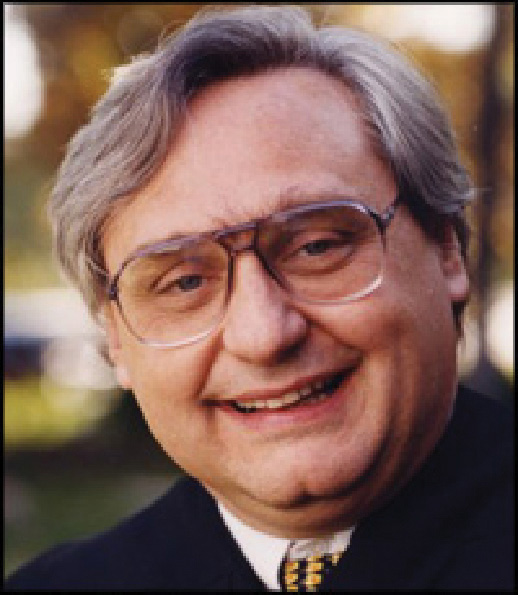
Source: Photo courtesy of the Ninth Circuit Court of Appeals, http://www.ce9.uscourts.gov/chief_judge_bio.html.
Judge Kozinski thinks that overprotecting intellectual property is as harmful as underprotecting it. Do you agree? The challenge for policymakers and courts is to find the balance between the rights of IP holders, who would always like more protection, and the rights of the public, which are enhanced when material falls into the public domain. Corporations, policymakers, and members of the public will all benefit from a reasoned debate over how to find this balance.